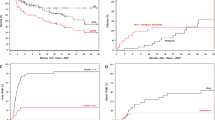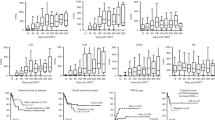Summary:
Stem cell transplantation (SCT) from a histocompatible sibling is treatment of choice for severe aplastic anemia. Survival rates have been reported to be as high as 90% for children. Immunosuppressive therapy (IST) is employed in patients who are not candidates for SCT due to donor unavailability. The addition of cyclosporin A to antilymphocyte globulin has improved the response rate to 70–80%, and survival at 5 years among responders is about 90%. In all, 30% of patients treated by IST suffer from relapse, but long-term prognosis does not appear to be affected by this complication. Juvenile myelomonocytic leukemia (JMML) shares both myelodysplastic and myeloproliferative features. Survival (10-year) of patients with JMML without SCT is only 6%. Children with JMML should be transplanted early in the course of their disease. Conditioning regimen composed of three alkylating agents, busulfan, cyclophosphamide and melphalan has been favored by the EWOG-MDS and EBMT-Pediatric WP in the second half of the 1990s. SCT using this conditioning regimen is capable of curing approximately 50% of patients with JMML. More than 70% of patients with refractory cytopenia and more than 50% of children with advanced MDS are cured of by the early performed allogeneic SCT.
This is a preview of subscription content, access via your institution
Access options
Subscribe to this journal
Receive 12 print issues and online access
$259.00 per year
only $21.58 per issue
Buy this article
- Purchase on Springer Link
- Instant access to full article PDF
Prices may be subject to local taxes which are calculated during checkout
Similar content being viewed by others
References
Young NS, Abkowitz JL, Luzzatto L . New insights into the pathophysiology of acquired cytopenias. Am Soc Hematol Educ Program Book 2000, 18–38.
Brown KE, Tisdale J, Barrett AJ et al. Hepatitis-associated aplastic anemia. N Engl J Med 1997; 336: 1059–1064.
Schrezenmeier H, Bacigalupo A, Aglietta M et al. Consensus document for treating aplastic anaemia. Consensus document of a group of international experts. In: Schrezenmeier H, Bacigalupo A (eds). Aplastic Anemia, Pathophysiology and Treatment. Cambridge University Press: Cambridge, 2000, pp 308–315.
Bacigalupo A, Bruno B, Saracco P et al. Antilymphocyte globulin, cyclosporine, prednisolone and granulocyte colony stimulating factor for severe aplastic anemia: an update of the GITMO/EBMT study on 100 patients. Blood 2000; 95: 1931–1934.
Frickhofen N, Kaltwasser JP, Schrezenmeier H et al. Treatment of aplastic anemia with antilymphocyte globulin and methylprednisolone with or without cyclosporine: the German Aplastic Anemia Study Group. N Engl J Med 1991; 324: 1297–1304.
Marsh JCW, Ball SE, Darbyshire P et al. Guidelines for the diagnosis and management of acquired aplastic anaemia. Br J Haematol 2003; 123: 782–801.
Tichelli A, Passweg J, Nissen C et al. Repeated treatment with horse antilymphocyte globulin for severe aplastic anemia. Br J Haematol 1998; 100: 393–400.
Schrezenmeier H, Marin P, Raghavachar A et al. Relapse of aplastic anemia after immunosuppressive treatment: a report from the European Bone Marrow Transplantation Group SAA Working Party. Br J Haematol 1993; 85: 371–377.
Frickhofen N, Heimpel H, Kaltwasser JP et al. Antithymocyte globulin with or without cyclosporine A: 11-year follow-up of a randomized trial comparing treatments of aplastic anemia. Blood 2003; 101: 1236–1242.
Kojima S, Horibe K, Inaba J et al. Long-term outcome of acquired aplastic anaemia in children: comparison between immunosuppressive therapy and bone marrow transplantation. Br J Haematol 2000; 111: 321–328.
Bacigalupo A, Locatelli F, Socié G et al. Fludarabine, cyclophosphamide and ATG for alternative donor transplants in aplastic anemia: a report of the SAA Working Party. Bone Marrow Transplant 2004; 33 (Suppl 1): S29.
Hasle H, Wadsworth LD, Massing BG et al. A population-based study of childhood myelodysplastic syndrome in British Columbia, Canada. Br J Haematol 1999; 106: 1027–1032.
Hasle H, Niemeyer CM, Chessells JM et al. A pediatric approach to the WHO classification of myelodysplastic and myeloproliferative diseases. Leukemia 2003; 17: 277–282.
Starý J . Experiences on MDS and JMML from the EWOG-MDS. In: Lopes LF, Hasle H (eds). Myelodysplastic and Myeloproliferative Disorders in Children. Lemar Livraria, Editora Marina and Tecmedd Editora: Sao Paulo, 2003, pp 277–296.
Niemeyer CM, Aricó M, Biondi A et al. Chronic myelomonocytic leukemia in childhood: a retrospective analysis of 110 cases. Blood 1997; 89: 3534–3543.
Locatelli F, Nollke P, Zecca M et al. Hematopoietic stem cell transplantation in children with juvenile myelomonocytic leukemia: results of the EWOG-MDS/EBMT trial. Blood 2005; 105: 410–419.
Yoshimi A, Niemeyer C, Bohmer V et al. Chimerism analyses and subsequential immunological intervention after stem cell transplantation in patients with JMML. Blood 2003; 102: 706a.
Kardos G, Baumann I, Passmore SJ et al. Refractory anemia in childhood: a retrospective analysis of 67 cases with particular reference to monosomy 7. Blood 2003; 102: 1997–2003.
Webb DKH, Passmore SJ, Hann IM et al. Results of treatment of children with refractory anaemia with excess blasts (RAEB) and RAEB in transformation (RAEBt) in Great Britain 1990–99. Br J Haematol 2002; 117: 33–39.
Locatelli F, Zecca M, Zintl F et al. Busulfan, cyclophosphamide and melphalan as preparative regimen to allogeneic stem cell transplantation in childhood MDS: results of the second interim analysis of the EBMT/EWOG-MDS study. Bone Marrow Transplant 2001; 27 (Suppl 1): S69.
Niemeyer C, Duffner U, Bender-Götze C et al. AML-type intensive chemotherapy prior to SCT does not improve survival in children and adolescents with primary MDS. Blood 2000; 96: 521a.
Strahm B, Greil J, Kremens B et al. A new conditioning regimen for patients with refractory anemia and congenital disorders. Bone Marrow Transplant 2003; 31 (Suppl 1): S26.
Niemeyer CM, Kontny U, Strahm B et al. SCT for children with secondary MDS: report from a multicenter study of the EWOG-MDS. Bone Marrow Transplant 2002; 29: S3.
Author information
Authors and Affiliations
Consortia
Corresponding author
Rights and permissions
About this article
Cite this article
Starý, J., Locatelli, F., Niemeyer, C. et al. Stem cell transplantation for aplastic anemia and myelodysplastic syndrome. Bone Marrow Transplant 35 (Suppl 1), S13–S16 (2005). https://doi.org/10.1038/sj.bmt.1704836
Published:
Issue Date:
DOI: https://doi.org/10.1038/sj.bmt.1704836
Keywords
This article is cited by
-
The current perspective of low-grade myelodysplastic syndrome in children
International Journal of Hematology (2016)
-
Rabbit-antithymocyte globulin combined with cyclosporin A as a first-line therapy: improved, effective, and safe for children with acquired severe aplastic anemia
Journal of Cancer Research and Clinical Oncology (2012)
-
Die individualisierte Riskoeinschätzung und Therapieplanung bei myelodysplastischen Syndromen
Wiener klinische Wochenschrift (2008)
-
Substitution of cyclophosphamide and busulfan by fludarabine, treosulfan and melphalan in a preparative regimen for children and adolescents with Shwachman–Diamond syndrome
Bone Marrow Transplantation (2007)



